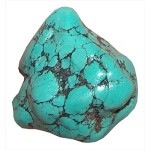Some say that in the thirteenth century, turquoise was named in the mistaken belief that it came from Turkey. That may be true or it may be that the name comes from the Persian word for turquoise, firouze, since Persia has been a major source of this gemstone for thousands of years. In any case, the blue of this gemstone is so vivid and distinct that it has given its name to the color.
Turquoise is one of the oldest known gem materials. The Egyptians were mining turquoise in 3,200 B.C. in the Sinai. The blue of turquoise was thought to have powerful metaphysical properties by many ancient cultures. Montezuma’s treasure, now displayed in the British Museum, includes a fantastic carved serpent covered by a mosaic of turquoise. In ancient Mexico, turquoise was reserved for the gods, it would not be worn by mere mortals.
The Apache believed that turquoise helped warriors and hunters to aim accurately. The Zuni believed that it protected them from demons. In Asia it was considered protection against the evil eye. Tibetans carved turquoise into rituals objects as well as wearing it in traditional jewelry. Ancient manuscripts from Persia, India, Afghanistan, and Arabia report that the health of a person wearing turquoise can be assessed by variations in the color of the stone. Turquoise was also thought to promote prosperity. In Europe even today, turquoise rings are given as forget me not gifts.
The most important turquoise deposits are in Iran, Tibet, China, and the Southwest United States. Turquoise is a mineral usually found in association with copper deposits. Turquoise is sometimes mined as a by-product of copper mining.
Turquoise from Iran is often said to be the best because it is sometimes a clear sky blue with no green modifying the color and no black veins running through it. Turquoise just as fine is produced in Arizona and New Mexico. In general, the bluer the blue, the more highly valued. A clear even texture without mottling or veins is also preferred. However, some people prefer turquoise with veins, sometimes called spiderwebs, which set off the color. Turquoise is porous and should be kept away from chemicals. Clean it with warm soapy water only.
Source: Taken from the Strata Gem, Toole G&MS Toole Utah, July 2005, via T-Town Rockhound, March 2006





